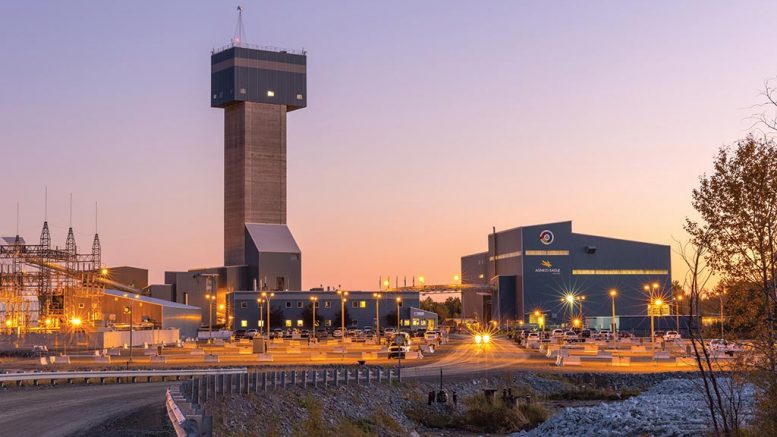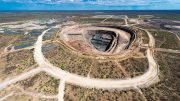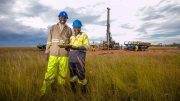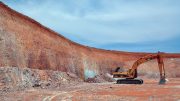The Northern Miner presents the top-10, Canada-headquartered mining companies by market capitalization as of late-June, 2020.
1. Barrick Gold
Market cap: US$46.56 billion

Barrick Gold’s Cortez gold mine in Nevada. Credit: Barrick Gold.
Barrick Gold (TSX: ABX; NYSE: GOLD) has gold and copper mining operations and projects in 13 countries in North and South America, Africa, Papua New Guinea and Saudi Arabia. Its diversified portfolio spans many of the world’s prolific gold districts, and the company is focused on high-margin, long-life assets.
Barrick operates six ‘tier one’ gold assets: Carlin (including the former Goldstrike operation) and Cortez, both in Nevada; Loulo-Gounkoto in Mali, Kibali in the Democratic Republic of Congo; Pueblo Viejo in the Dominican Republic; and Turquoise Ridge in the U.S. (To qualify for tier one status, a mine has to have annual production in excess of 500,000 oz., a mine life of at least ten years, and total cash costs in the bottom half of the industry range.) Last year, Carlin produced 1.3 million oz. gold; Cortez, 963,000 oz.; Kibali, 813,000 oz.; Loulo-Gounkoto, 715,000 oz.; Pueblo Viejo, 983,000 oz.; and Turquoise Ridge, 504,000 ounces.
Barrick merged with Randgold Resources in January 2019. That transaction was followed in July 2019 with the combination of Barrick’s Nevada assets with those of Newmont’s to create Nevada Gold Mines (61.5% owned and operated by Barrick). In September, it bought out the minority shareholders in Acacia and took over the management of its Tanzanian assets. Last year, the company saw its share price jump 78%. The company increased its dividend three times and almost halved its net debt to $2.2 billion – its lowest level since 2007.
2. Nutrien
Market cap: US$18.60 billion

Nutrien’s Rocanville potash mine in southeast Saskatchewan. Credit: Nutrien.
Nutrien (TSX: NTR; NYSE: NTR) was formed in a 2018 merger between Potash Corp. of Saskatchewan – the world’s largest potash produce – and Agrium, a retail supplier of agricultural products and service. Last year, Nutrien captured US$650 million in run-rate synergies – 30% higher than its commitment to shareholders at the time of the merger. Today, Nutrien is the world’s largest provider of crop inputs and services – producing potash, nitrogen and phosphate products – and has some of the world’s highest quality and lowest-cost crop nutrient production assets combined with an extensive agricultural distribution network.
The company has some of the world’s highest quality and lowest-cost crop nutrient production assets, combined with an unparalleled agricultural retail distribution network.
Last year, potash made up about 37% of the company’s earnings before interest, taxes, amortization and depreciation, nitrogen, 29%, and phosphate, 5%. Despite difficult market conditions in 2019 with challenging weather and escalating trade issues, Nutrien posted earnings before interest, taxes, depreciation and amortization of US$4.03 billion on sales of US$20.02 billion and generated free cash flow of US$2.2 billion. Since the company’s inception at the beginning of 2018 until the end of 2019, it has allocated US$5.7 billion to shareholders through dividends and share buybacks.
3. Agnico Eagle Mines
Market cap: US$14.99 billion

A headframe under construction at Agnico Eagle Mines’ Kittila mine in northern Finland in October 2019. Credit: Agnico Eagle Mines.
Agnico Eagle Mines (TSX: AEM; NYSE: AEM) has declared a cash dividend every year since 1983. It has mines in Canada, Finland and Mexico and last year brought two new mines into production in the Canadian Artic. Last year, it exceeded its annual production forecast for the eighth year in a row – producing 1.78 million oz. gold at total cash costs of $673 per oz. and posted net income for the year of US$473.2 million.
The company has two producing mines in Nunavut – the Meadowbank Complex and the Meliadine mine. In Quebec it owns the La Ronde complex, Goldex, and Canadian Malartic mines, in Mexico the La India, Pinos Altos and Creston Mascota mines, and in Finland the Kittila mine. Its exploration projects include Hammond Reef in northwestern Ontario; Kirkland Lake in northeastern Ontario; Odyssey, East Gouldie and East Malartic in Quebec; and Santa Gertrudis in Mexico’s Sonora state. Agnico has one of the highest mineral reserve grades among its North American peers. The company’s goal is to maintain its global mineral reserves at about ten times its annual gold production rate. It had cash and equivalents at the end of 2019 of US$322 million.
4. Kirkland Lake Gold
Market cap: $10.96 billion

A headframe at Kirkland Lake Gold’s Macassa gold mine in northeastern Ontario. Credit: Kirkland Lake Gold.
Kirkland Lake Gold (TSX: KL; NYSE: KL) operates two of the highest grade gold mines in the world and produced a record 974,615 oz. gold in 2019, a 35% year-on-year increase, anchored by its Macassa mine in Ontario, Canada, and its Fosterville mine in the state of Victoria, Australia. It also produces gold at its Holt complex — a trio of mines (Holt, Taylor and Holloway) in Ontario.
Last year, Kirkland Lake Gold’s consolidated operating cash costs fell 22% year-on-year to US$284 per oz. sold, while all-in sustaining costs (AISCs) declined 18% to US$564 per oz. sold. Net earnings jumped 104% year-on-year to US$560 million, or $2.67 per share, and free cash flow totalled US$463 million, an 81% increase over 2018. The company’s shares rose by 60% in 2019, it raised its dividend twice and more than doubled its cash position, ending 2019 with US$707 million in cash and equivalents.
In January 2020, the company completed the all-share acquisition of Detour Gold, adding Detour’s mine in northern Ontario to its portfolio of producing assets. The transaction added 14.8 million oz. gold in open-pit reserves to the company’s mineral reserve base and exploration targets within its 1,040 sq. km land position in the Abitibi Greenstone belt.
All three of the company’s main mines — Macassa, Fosterville and Detour — feature free-cash-flow generating operations, in-mine growth potential and regional exploration upside. Last year, the company repurchased 1.13 million of its common shares and plans to buy back another 20 million shares over the next 12 to 24 months.
The company is also making strides with new technology, automation and artificial intelligence. Its Macassa mine has a fully electric fleet.
5. Kinross Gold
Market cap: US$8.87 billion

Looking over the Round Mountain gold operation in Nye County, Nevada. Credit: Kinross Gold.
Kinross Gold’s (TSX: K; NYSE: KGC) mines in the Americas, Russia and West Africa delivered 2.5 million gold-equivalent oz. at a production cost of sales of US$706 per gold-equivalent oz. last year, generating over US$1.2 billion in adjusted operating cash flow. It ended 2019 with total liquidity of more than US$2 billion.
Fifty-six percent of its production in 2019 came from the Americas, 23% from West Africa and 21% from Russia. The company has mines in the Americas: Fort Knox (U.S.); Round Mountain (U.S.); Bald Mountain (U.S.); and Paracatu (Brazil). It has two operating mines in West Africa: Tasiast in Mauritania and Chirano in Ghana, and two mines in Russia: Kupol and Dvoinoye.
Its three largest mines – Paracatu (Brazil), Kupol (Russia) and Tasiast (Mauritania) – accounted for more than 61% of the company’s annual production last year. Last year, Paracatu set an annual production record of 620,000 gold-equivalent ounces.
The company is proceeding with a project at its Tasiast mine to incrementally increase throughput capacity to 24,000 tonnes per day by mid-2023. In January, it closed the acquisition of a new project in Russia – Chulbatkan – and expects to update the resource before the end of 2020. Earlier this year, Kinross announced its decision to proceed with the restart of La Coipa in Chile, which is expected to begin adding ounces to its production profile in 2022.
6. Pan American Silver
Market cap: US$5.94 billion

Pan American Silver’s Dolores silver-gold mine in Chihuahua, Mexico. Credit: Pan American Silver.
Pan American Silver (TSX: PAAS; NYSE: PAAS) is the world’s second-largest primary silver producer and owns mines in Peru, Mexico, Canada, Argentina and Bolivia. Last year, the company celebrated its silver jubilee – 25 years of mining operations throughout the Americas. Last year, it also acquired Tahoe Resources, which brought it four new gold mines (two each in Canada and Peru) and the Escobal silver mine in Guatemala, which has been on care and maintenance since 2017 pending a government-led consultation process.
In Peru, it owns the Huaron underground mine; the Morococha underground mine; the La Arena open pit mine; and the Shauhindo open pit mine. In Mexico, it owns the La Colorada underground mine in Zacatecas, its largest silver producer, and the Dolores open-pit and underground mine in Chihuahua. In Canada, its Timmins underground mines include Timmins West and Bell Creek. In Bolivia, it owns the San Vincente underground mine and in Argentina, the Manantial Espejo underground mine.
Pan American also owns 100% of the Navidad project in Argentina, one of the largest undeveloped primary silver deposits in the world. Navidad contains an estimated 632 million measure and indicated oz. silver.
Last year, 43% of the company’s revenue came from Peru, 31% from Mexico, 15% from Canada; 6% from Bolivia; and 5% from Argentina. Pan American produced 25.9 million oz. silver and 559,200 oz. gold at all-in sustaining costs (AISCs) of US$10.46 per oz. silver and US$948 per oz. gold. (It also produced 67,600 tonnes of zinc, 27,300 tonnes of lead and 8,700 tonnes of copper.) The company posted net earnings of US$111.2 million on revenues of US$1.35 billion. Pan American generated US$282 million in cash flow and it retired US$60 million of debt, bringing its net debt down to US$78 million at year-end. Pan American ended 2019 with reserves of 557 million oz. silver and 5.1 million oz. gold.
7. B2Gold
Market cap: US$5.65 billion

Haul trucks in the pit at B2Gold’s Fekola gold mine. Credit: B2Gold.
B2 Gold (TSX: BTO; NYSE-AM: BTG) was founded in 2007 and now has mines in Mali, Namibia and the Philippines and exploration projects in several countries including Mali, Namibia, Burkina Faso, Colombia and Finland. It owns 80% of the Fekola mine, an open-pit gold mine in Mali; 90% of the Otjikoto mine, an open pit mine in Namibia (an underground component is under development); and Masbate, an open pit gold mine in the Philippines. Its other primary assets include the Gramalote gold project in Colombia and the Kiaka gold project in Burkina Faso.
Last year, the company sold its La Libertad and El Limon mines and its Pavon gold project in Nicaragua to Calibre Mining. (B2Gold now owns about 34% of Calibre Mining.) Other 2019 highlights include a decision to proceed with an expansion project at its Fekola mine to 7.5 million tonnes per year, a 1.5 million tonne per year increase, and the approval of an off-grid grid solar plant for the mine. The solar plant will be one of the largest off-grid hybrid-solar/heavy fuel oil (HFO) plants in the world, with a 30-megawatt solar component combined with 64 MW of HFO and diesel generating capacity.
Last year, B2Gold reported record consolidated production of 969,495 oz. gold at cash operating costs of US$519 per oz. sold and AISCs of US$862 per oz. sold. The company generated cash flow of US$492 million and posted net income attributable to shareholders of US$293 million.
8. Teck Resources
Market cap: US$5.29 billion

Teck Resources’ Highland Valley copper-molybdenum mine, 50 km southwest of Kamloops, British Columbia. Credit: Teck Resources.
Teck Resources (TSX: TECK.B; NYSE: TECK) is focused on steelmaking coal, copper, zinc and energy and owns or has interests in 11 operating mines, a large metallurgical complex and several major development projects in the Americas. It is the world’s second-largest seaborne exporter of steelmaking coal with five operations in Western Canada and is a significant copper producer in the Americas, with four operating mines in Canada, Chile and Peru and copper development projects in North and South America. Teck is also one of the world’s largest producers of mined zinc, with two operating mines in the U.S. and Peru, and owns one of the world’s largest fully integrated zinc and lead smelting and refining facilities in Canada. It also has an interest in the Fort Hills oil sands mine in Alberta.
Its steelmaking coal operations include Cardinal River, Fording River, Greenhills, Line Creek and Elkview. Its copper portfolio includes Highland Valley Copper, Antamina, Quebrada Blanca and Carmen de Andacollo. Its zinc assets are Red Dog and Trail and energy assets Fort Hills.
Last year, the Vancouver-headquartered company posted revenues of $11.9 billion and cash flow from operations of $3.5 billion. Adjusted EBITDA came in at $4.3 billion with adjusted profit attributable to shareholders of $1.6 billion. Teck returned $111 million in cash to shareholders through dividends last year and announced $600 million in share buybacks, of which about $393 million were completed in the calendar year. Teck ended the year with $1 billion in cash and $6.2 billion of liquidity.
9. Yamana Gold
Market cap: US$5.04 billion

Pit activity at Agnico Eagle Mines and Yamana Gold’s Canadian Malartic gold mine in Quebec. Credit: Yamana Gold.
Yamana Gold (TSX: YRI; NYSE: AUY) has assets in Canada, Brazil, Chile, and Argentina. It owns 50% of the Canadian Malartic open-pit gold mine in Quebec; 100% of the Jacobina underground mine complex in Brazil; 100% of the El Penon underground silver-gold mine and 100% of the Mineral Florida underground gold-silver mines in Chile; and 100% of the Cerro Moro open-pit/underground mine in Argentina. In addition, it owns the Agua Rica copper-gold-silver and molybdenum project in Argentina. The company has consistently paid dividends since 2007, aggregating to more than US$900 million in dividends paid over the last 12 years.
In 2019, Yamana produced 900,339 oz. gold and 10.64 million oz. silver (1.02 million gold-equivalent ounces). Net earnings attributable to the company’s shareholders totalled US$225.6 million, including the sale of its Chapada mine in Brazil for an initial upfront cash consideration of US$800 million on closing in July 2019 (and a total cash consideration of US$865.5 million.) The company’s operations generated net free cash flow of US$358.4 million. Net debt decreased to US$889.1 million, and at the end of 2019 Yamana had cash and equivalents of US$158.8 million and available credit of US$750 million.
Other highlights of the year included the discovery of East Gouldie, a new mineralized zone at the Canadian Malartic mine. Yamana spent US$68.3 million on total exploration in 2019.
10. Cameco
Market cap: US$4.01 billion

Cameco’s Cigar Lake uranium mine in northern Saskatchewan. Credit: Cameco.
Cameco‘s (TSX: CCO; NYSE: CCJ) operations and investments span the nuclear fuel cycle, from exploration to fuel manufacturing. The company is one of the world’s largest uranium producers with assets on three continents. It sells uranium and fuel services to nuclear utilities in 12 countries, with sales commitments to supply about 130 million lb. U3O8 and over 36 million kilograms of UF6 conversion services. Its uranium operations include Cigar Lake, McArthur River/Key Lake and Rabbit Lake in northern Saskatchewan; Inkai in Kazakhstan; and Smith Ranch-Highland in Wyoming and Crow Butte in Nebraska. Its advanced projects include Millennium in northern Saskatchewan and Kintyre and Yeelirrie in Western Australia.
In its fuel services division, it owns the Blind River refinery, the world’s largest uranium refinery; the Port Hope Conversion facility, one of only four commercial suppliers in the western world of uranium hexafluoride (UF6), which is exported to be enriched for use in light water reactors; and Cameco Fuel Manufacturing, the largest Canada-based supplier of components for CANDU reactors.
Last year, with many of its uranium mine operations on care and maintenance, it produced 9 million lb. U3O8 and generated $527 million in cash from operations and posted net earnings attributable to shareholders of U$74 million. (Its suspension of McArthur River/Key Lake alone removed 18 billion lb. per year of U3O8 from the market.) Highlights from 2019 include the signing of a binding agreement to increase its interest in Global Laser Enrichment (GLE) from 24% to 49%. GLE is testing a third-generation enrichment technology that, if successful, will use lasers to commercially enrich uranium.






The Canada mining industry contiues to be a key player in solving the world’s environmental problems.The G7 and G20 Summits and APEC (AsiaA-Pacific Economic Conference) will comtine to do so, and NEPAD (New Partnership for Africa’s Development) will this year follow their lead. The CAT Company for more than 20 years has been a conduit re. concerned global governmental and business leaders to showcase activity and messages at these events.